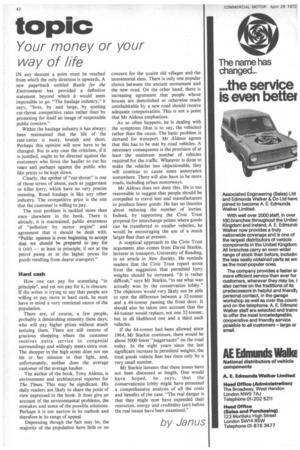topic
Page 44

If you've noticed an error in this article please click here to report it so we can fix it.
Your money or your way of life
IN any descent a point must be reached from which the only direction is upwards. A
new paperback entitled Battle for the Environment has provided a definitive
statement beyond which it would seem impossible to go. "The haulage industry," it says, "lives, by and large, by quoting cut-throat competitive rates rather than by promoting for itself an image of responsible public concern."
Within the haulage industry it has always been maintained that the life of the rate-cutter is nasty, brutish and short.
Perhaps this opinion will now have to be changed. But in any case the criticism, if it is justified, ought to-be directed against the customers who force the haulier to cut his rates and perhaps against the public who like prices to be kept down.
Clearly, the epithet of "cut-throat" is one of those terms of abuse, such as juggernaut or killer lorry, which have no very precise meaning. Road haulage is like any other industry. The competitive price is the one that the customer is willing to pay.
The cost problem is tackled more than once elsewhere in the book. There is already, it is maintained, public awareness of "pollution by motor engine" and agreement that it should be dealt with.
"Public opinion is even beginning to accept that we should be prepared to pay for it (sic) — at least in principle, if not at the petrol pump or in the higher prices for goods resulting from dearer transport."
Hard cash How one can pay for something "in principle", and yet not pay for it, is obscure. If the writer is trying to say that people are willing to pay more in hard cash, he must have in mind a very restricted sector of the population.
There are, of course, a few people, probably a diminishing minority these days, who will pay higher prices without much noticing them. There are still centres of gracious shopping where the customer receives extra service in congenial surroundings and willingly meets extra cost. The shopper in the high street does not see his or her mission in that light, and, unfortunately, neither does the average customer of the average haulier.
The author of the book, Tony Aldous, is environment and architectural reporter for The Times. This may be significant. His daily readers are likely to share the point of view expressed in the book. It does give an account of the environmental problems, the mistakes and some of the possible solutions. Perhaps it is too narrow in its outlook and therefore in its range of appeal.
Depressing though the fact may be, the majority of the population have little or no
concern for the quaint old villages and the immemorial elms. There is only one popular choice between the ancient monument and the new road. On the other hand, there is increasing agreement that people whose houses are demolished or otherwise made uninhabitable by a new road should receive adequate compensation. This is not a point that Mr Aldous emphasizes.
As so often happens, he is dealing with the symptoms (that is to say, the vehicles) rather than the cause. The basic problem is demand for transport. Mr Aldous agrees that this has to be met by road vehicles. A necessary consequence is the provision of at least the minimum number of vehicles required for the traffic. Whatever is done to make the vehicles less objectionable, they will continue to cause some annoyance somewhere. There will also have to be more roads, including urban motorways.
Mr Aldous does not deny this. He is too reasonable to suggest that people should be compelled to travel less and manufacturers to produce fewer goods. He has no theories about reducing the number of lorries. Indeed, by supporting the Civic Trust proposal for interchange points where goods can be transferred to smaller vehicles, he would be encouraging the use of a much larger fleet than at present.
A sceptical approach to the Civic Trust arguments also comes from David Starkie, lecturer in transport, University of Reading, in an article in New Society. He reminds readers that the Civic Trust report arose from the suggestion that permitted lorry weights should be increased. "It is rather difficult," says Mr Starkie, "to see what was actually won by the conservation lobby." The objectors would very likely not be able to spot the difference between a 32-tonner and a 44-tonner passing the front door. It should also be taken into account that the 44-tonner would replace, not one 32-tonner, but in all likelihood one and a third such vehicles.
If the 44-tonner had been allowed since 1964, Mr Starkie continues, there would be about 5000 fewer "juggernauts" on the road. today. In the eight years since the last significant increase in permitted weights, the total goods vehicle fleet has risen only by a very small number.
Mr Starkie laments that these issues have not been discussed at length. One would have hoped, he says, that the conservationist lobby might have presented a comprehensive analysis of all the costs and benefits of the case. "The real danger is that they might now have expended their resources, energy and credibility (sic) before the real issues have been examined."
by Janus








































































































